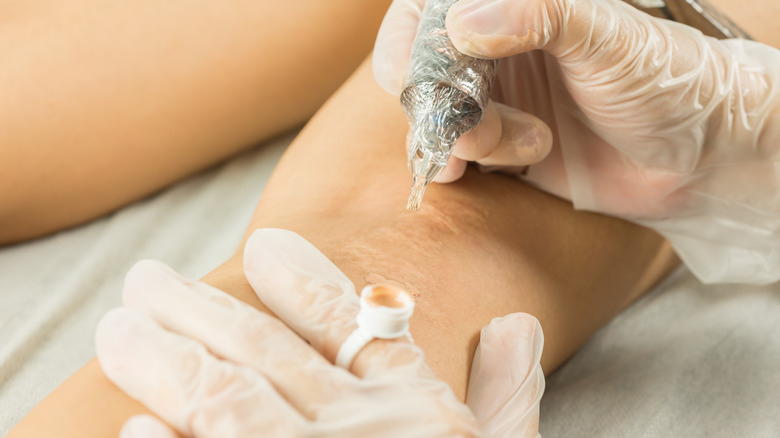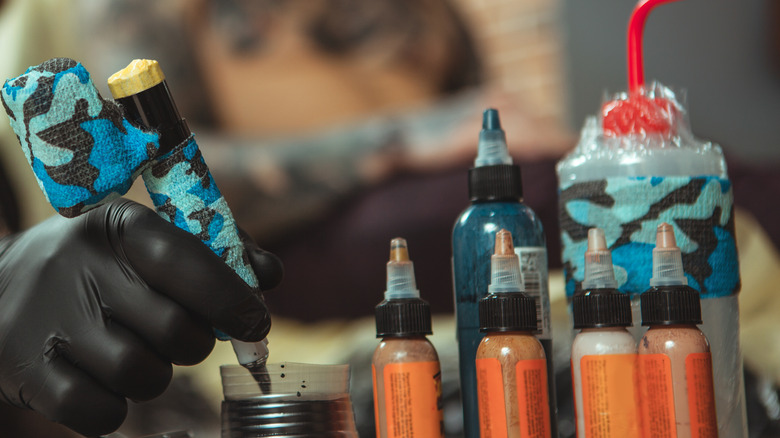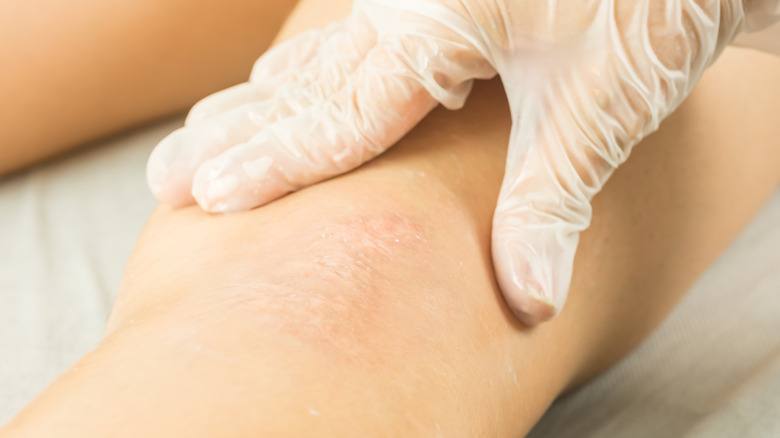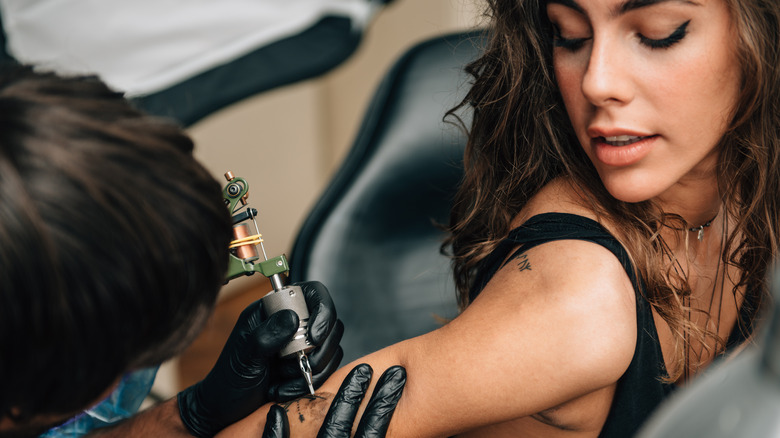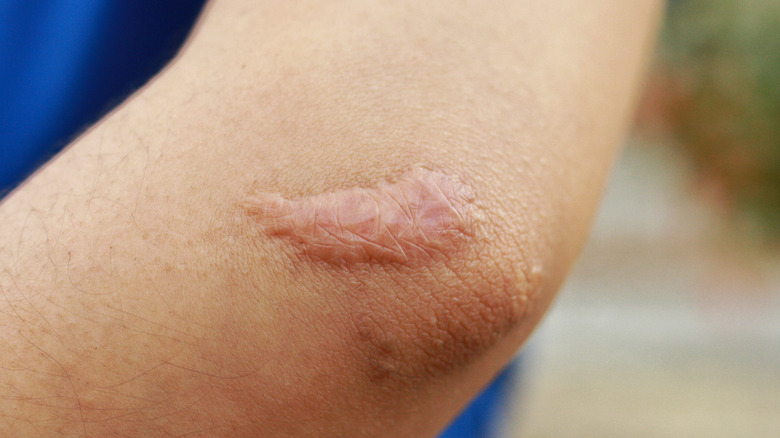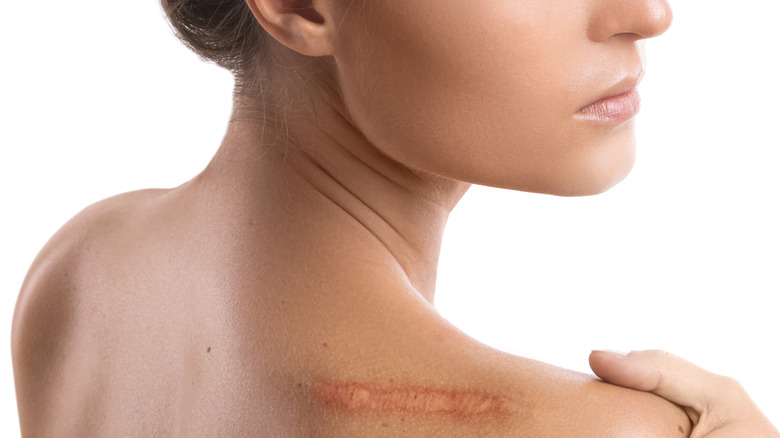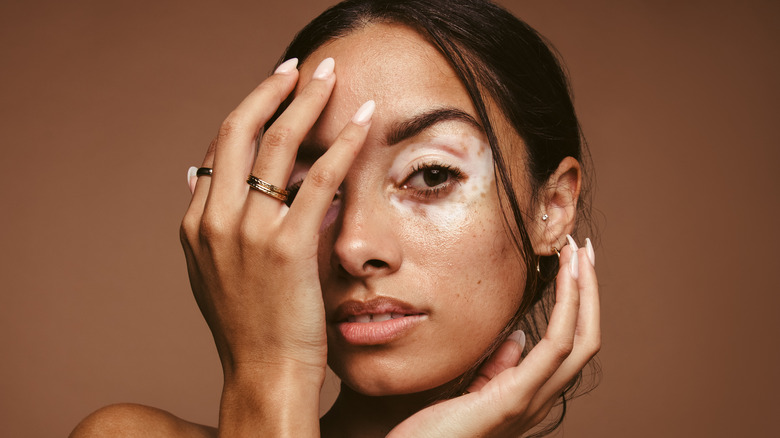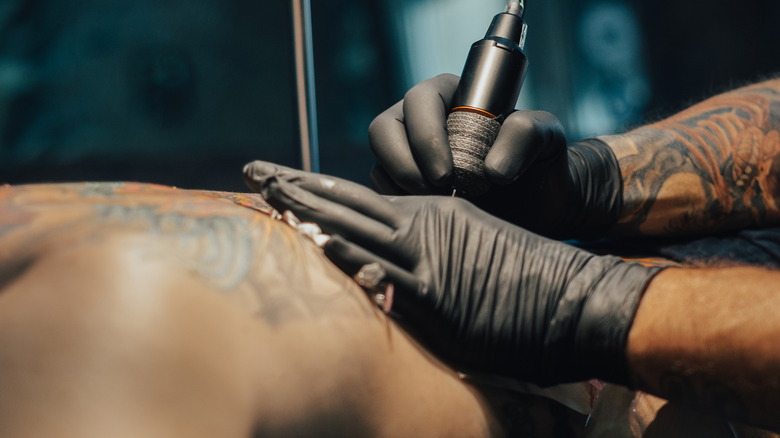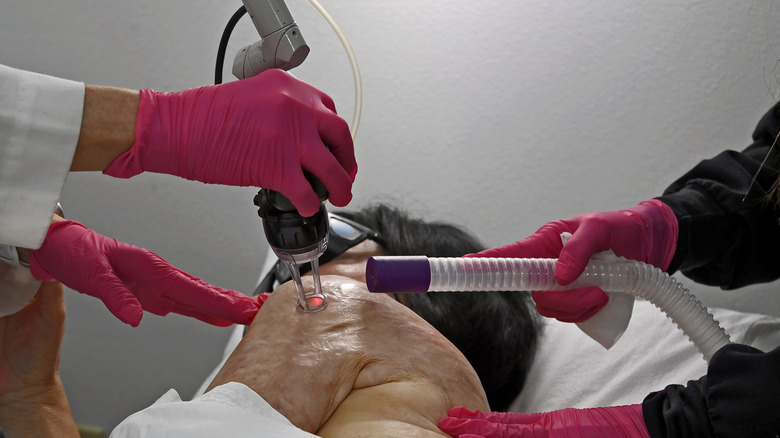Scar Camouflage Tattoos Are A Real Option (& Can Boost Your Confidence)
You can embrace your scars and let them tell a story because each mark reflects something that's happened to you and is unique in color, shape, and size. But some scars have a negative association, and you may feel they'd be better covered up. The process of doing so could be empowering and make you feel more confident about your body.
Tattoo cover-ups and procedures like scar camouflage tattoos have had fantastic results, reducing the visibility of the scar and making it blend better with the surrounding skin. The scar will not be hidden completely but will become less noticeable. This treatment camouflages the scar using corrective pigmentation techniques that will match the color of the scar with the surrounding skin and could be a good option for those wanting natural results. It makes the scar less visible without fully concealing it, which is different than if you were to cover the scar with conventional methods of tattooing. This can be a beautiful way to take ownership of your body and be another important step in healing physically and mentally.
If this sounds like something you would be interested in, it's essential to understand the limitations of scar camouflage tattoos before you opt for this procedure. For example, not all types of scars can be covered, some will have better results than others, you must wait until the scar is fully healed, and there is discomfort and cost to consider.
How do scar camouflage tattoos differ from traditional tattoos?
Scar camouflage tattoos are considered a form of permanent cosmetics and must be done by a skilled technician. They are not injected as deeply into the dermis and are considered semi-permanent. They are also created using micro pigments to match the skin tone. In contrast, tattoo artists can cover scars with different designs and in your chosen colors. This option is used to conceal the scar rather than trying to match the skin color and reduce its visibility. Both options are beautiful and will appeal to those looking to forget the memory of their scars.
There are some stunning ways that the scar can be incorporated into the design, some even using the uneven texture to create an almost 3D finish. The traditional approach to tattooing is permanent, and for the best results, you need a professional tattoo artist with experience covering scars. "Again, I can't stress having an experienced tattooer do the cover up enough. Because of the different skin texture in scars, there is a way higher chance of blowouts, blurring, [and] spotty healing," tattoo artist Anka Lavriv tells Brydie. Both approaches will need aftercare, so clarify what this will entail with the professional who does your tattoo.
How are camouflage tattoos created?
Scar camouflage or a skin coloring tattoo is a treatment performed to reduce the scar's visibility. It's a specialized tattooing technique that is considered a form of permanent cosmetics. It involves evaluating your scar type and how old it is. You cannot cover a scar that is still healing, and doing so could result in several complications.
The technician uses the corrective pigmentation technique to create an ink formulation that blends different colors to match your skin tone. To account for the natural difference of tones in the skin, the technician might also use the pointillism technique (via Prettyology), which gives more variety. You can ask the professional performing the procedure about all the steps involved.
Scar camouflage won't cover the scar entirely but can create a more natural result. Depending on the appearance of your scar, the technician may also suggest using other treatments alongside the procedure, for example, microneedling or laser. "Used with medical needling, I am able to adjust both the texture and colour [of the scar] for more effective camouflage. This technique will also stimulate the body's wound-healing response," Suki Mezei, Suki Su Permanent Natural Makeup owner, says.
The tattooing process can be more painful
How painful a tattoo is depends on several factors, including the location, size, and your pain tolerance. It can be challenging to determine how much discomfort you'll experience during the procedure, and the medical technician or tattoo artist will be able to give you a better understanding based on your scar type, how deep it is, and the location on your body. However, it's generally agreed upon that tattooing over scars versus unscarred skin will cause much greater discomfort. Pain is something to consider before committing to such a life-changing treatment, and for some people, this may be a deal-breaker.
If your scar is over an area with a high concentration of nerves or you have experienced nerve damage, this will heighten the pain (via Healthline). Another consideration is that some types of scars, like keloid scars, are more challenging to cover because of their raised appearance, color, and texture. They're also more likely to cause complications and greater discomfort during the tattoo treatment.
Can all types of scars be covered?
Not all scar tissue is the same, and there are different types, including keloid, acne, atrophic, and burn scars. Before deciding to cover your scar with a tattoo, you need to understand the procedure and how it can affect the scarred skin better. Scars that are deeper or more raised and textured in appearance are more challenging to cover up.
Whether you opt for a traditional tattoo cover-up or scar camouflage tattoos, the questions you want to ask the medical technician or the tattoo artist are the same. You should also book a consultation beforehand, so they can assess your scar and determine the best approach. "Take extra precaution when working with scars that leave the skin very thin, fragile, and overly stretched as this can cause excess trauma to delicate areas," says tattoo artist Shaughnessy Otsuji to Byrdie. "Scars that are very raised and textured should also be approached with caution as to not cause more damage."
You can't tattoo over a fresh scar (so be patient)
Your scar needs to be fully healed before it can be evaluated for scar camouflage. The medical technician will then determine if it is possible to cover the scar (because not all scars are the same, and some are more complicated to cover or are more sensitive). Waiting for your scar to heal can take years, most commonly anywhere between one to five years. "I would say wait a full year before tattooing over a scar. However, it also depends on the severity of the scar, how much trauma, heal time, etc," tattoo artist Gianna Caranfa tells Byrdie.
While this may seem like a long time to wait before being able to get the procedure, no skilled professional will tattoo over an unhealed scar, as this will increase the risk of complications involved. This could include infection, scar irritation, and sometimes even result in the scar reopening. This is also why choosing someone skilled with experience and knowledge of scar tissue is incredibly important.
Can the procedure be used on conditions that affect pigmentation?
Vitiligo is an autoimmune condition that affects the pigmentation in the skin, and some people may be tempted to try a scar camouflage tattoo to cover it. As mentioned, this technique is a skin coloring tattoo blended to match your skin tone best and reduce the visibility of scars or pigmentation. For vitiligo, the procedure is possible, but it's not always recommended.
Scar camouflage for a person with vitiligo may cause a reaction that will spread to other areas (via Studio Conceal). If you are tempted to try it and see how your body reacts, it is advisable to have a consultation with an experienced technician who will perform a patch test (which will focus on a small section of skin first). If the results of this test are favorable, you can move forward and receive the treatment in a larger area.
Be realistic with your expectations and consider not all results are the same
What works for one person will not necessarily work for someone else, which is something to remember before your appointment. You may see remarkable before and after photos from your chosen technician or tattoo artist but feel disappointed after getting your scar camouflage tattoo.
The process is designed to blend the scar with the surrounding skin, producing a more faded and natural result. This is achieved with a clever mix of color pigments created to match your skin tone. But you need to understand the procedure fully and the type of scar so you have realistic expectations. When armed with this knowledge, it will reduce the chances of feeling let down.
"When I get requests for scar cover-ups, I always have a consultation with the client, assess the scar [in terms of] severity, age, color, placement, and have a conversation about what is the client's goal with this tattoo," tattoo artist Anka Lavriv tells Byrdie. "Chances are that it won't be possible to make the scar disappear altogether, but there is a lot that usually can be done in terms of concealing, blending it in with the design, and drawing attention away from the scar."
Don't be afraid to ask questions
It is a big decision to get a tattoo. While many people are impressed with the results of scar camouflage tattoos (considered a form of permanent cosmetics), asking the trained professional about the procedure in depth can make you feel more comfortable. There are no bad questions, and you want your mind to be at ease.
You also want to do your research to make sure the person performing the procedure is qualified, including evaluating their credentials and experience. Find out more about the facility where the treatment will take place, and ask if they have reviews or photos where you can see the results of the work they have done before. This will help you decide whether the techniques and micro pigments used are right for you. Having confidence in the person you choose and their expertise will reduce the risks of infection and ensure better results.
Like all tattoos, there could be potential risks involved in covering scars
When you undergo any procedure that involves putting needles into the skin, there are potential risks involved, including infection. With camouflage tattoos, there is also the possibility of an allergic reaction to the pigment (containing Titanium Dioxide) used to cover the scar.
Cleanliness is essential, so choose the procedure facility carefully, but you also need someone who knows what they are doing. When a skilled technician is performing the procedure, complications are less likely. Cosmetic and restorative tattoo artist Nicole Johnston reveals to AEDIT how important it is to find the right person to perform this procedure and how honest communication can make a big difference. "Scars are complicated and every situation is different," she says. "If an artist gives you an immediate 'yes' without indications of what to expect with your results, you may want to keep researching. I regularly turn away clients if I know I cannot make worthwhile improvements."
Who should avoid getting tattoos over their scars?
Not everyone is eligible for this procedure; some people should avoid covering their scars completely. This includes individuals who are immuno-compromised because their bodies will take longer to heal and the tattoo is more likely to result in infection. Other people who should avoid getting any procedures are pregnant women or women looking to become pregnant and anyone with damaged skin, for example, if you are sunburnt.
"Tattoos should be thought of as a medical procedure as it poses similar risks as minor surgery does," board-certified plastic surgeon Stephen Greenberg tells The List. "Patients run the risk for an immediate or delayed infection, poor healing, poor scarring, localized or systemic reaction to the ink/dye, and there have also been reported cases of infectious disease transmission from dirty needles and instruments. While some of these risks can be treated with antibiotics, many of these risks pose long-term consequences."
You may need laser treatment or microneedling first
Scar camouflage tattoos are a great way to disguise your scars and reduce their visibility. Unlike tattooing over them completely with a design, this approach is done by coloring the scars to look as faded and natural as possible. Still, different scar tissue will have varying results, and sometimes, for the best possible outcome, your consultant may recommend that you have laser treatment or microneedling first. "Often, I will recommend a client get laser or microneedling done on a scar prior to coming to me so that we can see the best results," cosmetic and restorative tattoo artist Nicole Johnston tells AEDIT. "Laser and microneedling will help flatten the scar and improve its texture."
Microneedling is a skin procedure that uses thin needles to make holes in the skin. This is done to encourage collagen and elastin production and can be used to treat several skin-related concerns, including scars (via Cleveland Clinic). As for laser treatment, this procedure can be used in several ways, and the wavelength is adjusted for each option. This includes removing tattoos or focusing on improving the appearance of scars. This particular treatment would be a cosmetic approach that uses light to create heat, which is then targeted in a specific area (via Very Well Health).
How expensive are scar camouflage tattoos?
The cost of covering your scar will depend on several factors, including the type of scar and the size. Regardless, the procedure is not cheap, and most people will pay up to $1000. Depending on the size and type of scar you have, your technician may also recommend several consultations for the best results. Some scars also hold color better than others. If it is suggested you undergo other treatments first to improve the coloring or texture of your scar, this is another factor that will influence the price.
"I always tell my clients that they shouldn't expect to see immediate results," cosmetic and restorative tattoo artist Nicole Johnston tells AEDIT. "In order for the results to look the most natural, I am conservative with the amount of color I add in one session to the scar," she explains. "My focus is for the result to look like skin and not like I've applied makeup to the area." She says that "clients will see full results after their touch up session."
This is why it is helpful to have a consultation beforehand to have a realistic expectation of the cost and the results you can hope to see. In contrast, a conventional tattoo may cost less, but the results differ vastly.
